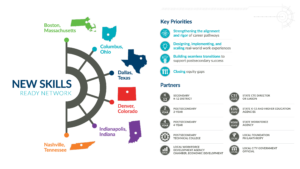In February 2020, JPMorgan Chase & Co. announced its New Skills ready network initiative, which bolsters the firm’s efforts to support an inclusive economic recovery. This effort is part of both their $350 million, five-year New Skills at Work initiative to prepare people for the future of work and their $30 billion commitment to advance racial equity.

While there was a lot of excitement – and some uncertainty – about how exactly the work would unfold, we had no idea that, in just a few short weeks after the launch, the world would change as we knew it. Plans of in-person leadership team meetings, extended needs assessments that included focus groups of learners, industry partners and other key stakeholders, and network-wide convenings were all put on hold or adjusted due to the pandemic.
While the ramp up may have slowed down and plans evolved, what never changed was the commitment of the six sites, JPMorgan Chase & Co., Advance CTE and our national partner, Education Strategy Group (ESG) to the ultimate vision of this initiative – to dramatically increase equitable access to and success in high-quality career pathways and experiences that lead to good jobs for all learners across these communities. This became even more important as the pandemic laid bare the deep and abiding inequities in our education system, workforce and society, particularly for learners and communities of color.
We are now two-and-a-half years into the five-year initiative and there is a lot to celebrate! New Skills ready network is a bold and audacious initiative that aims to achieve both systems change at the ecosystem level while also improving programmatic opportunities for learners and industry partners in real time. It is no easy feat to build a career preparation ecosystem that engages and brings along K-12 districts, two- and four-year institutions, intermediaries, state agencies and industry partners – while also implementing new pathways, advising structures and other critical programmatic improvements at the school and institutional level.
So what have we learned?
- Programmatic improvements are critical but can always be swept away with a change in leadership, funding or priorities. To achieve true sustainable change and equitable opportunities requires a focus on the overall systems. We’re impressed at how sites are focusing on the system-level work of building true buy-in, deepening partnerships between the state and local level and across institutions, and strengthening data collection, sharing and use across partner organizations.
- Equity must be at the core of the work – as both a moral and economic imperative. As such, sites are engaging learners and families to understand their motivations and concerns, assessing the cultural wealth and assets within school buildings, providing ongoing professional development to system leaders and instructors to build shared understanding of systemic barriers to equity and other key activities.
- In order to build sustainable systems, sites can’t simply add new pathways and related experiences, but also must transform or sunset what isn’t working – be it outdated advising models, misaligned pathways or work-based learning that isn’t accessible or meaningful to learners.
- New Skills must be built into the communities’ broader career pathways ecosystem. Given the increased interest and investments in career pathways over the last decade, we are finding that the work supported by New Skills is an accelerant to those efforts – or even the glue that holds them together.
For more on site-specific progress, check out the:
- 2021-22 New Skills ready network snapshots and annual report.
- Videos and graphics, released by ESG, elevating the sites’ “big bets” for the year ahead.
Kate Kreamer, Deputy Executive Director
Tags: career pathways, Colorado, Data Collection, Equity and Access, Indiana, Massachusetts, New Skills ready network, Ohio, tennessee, texas

